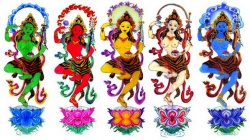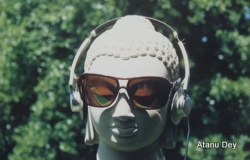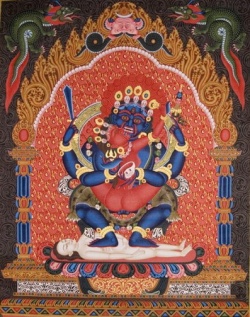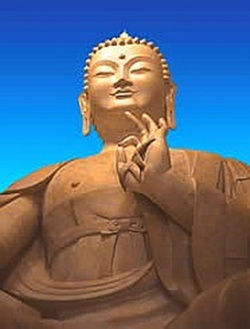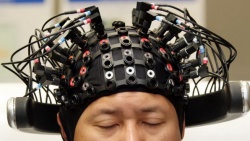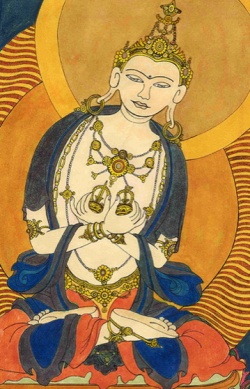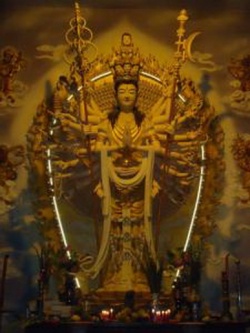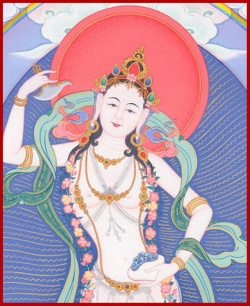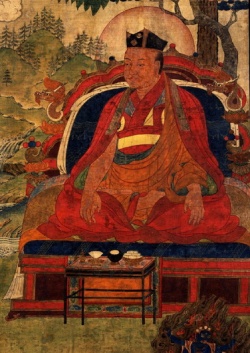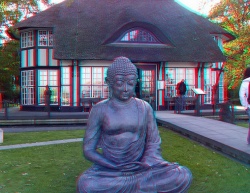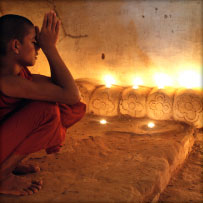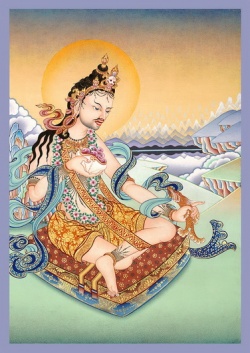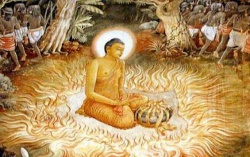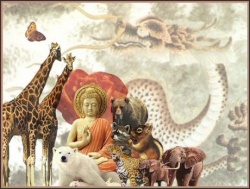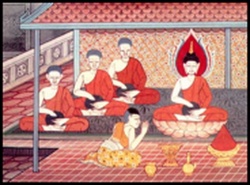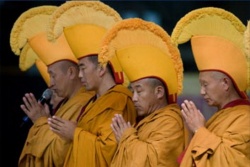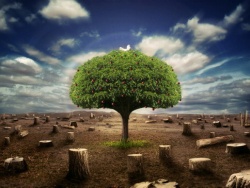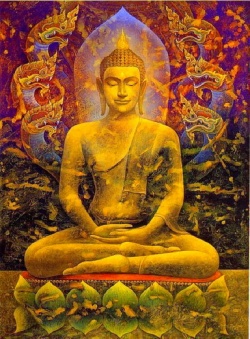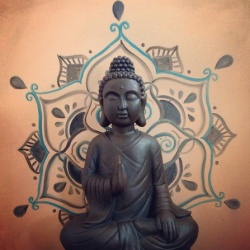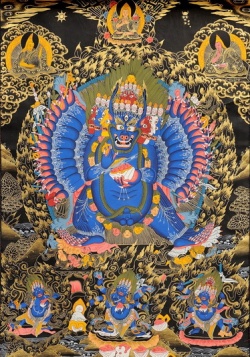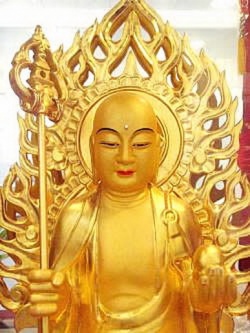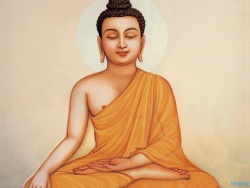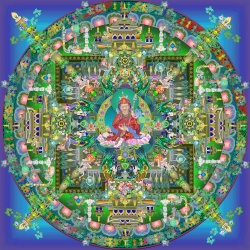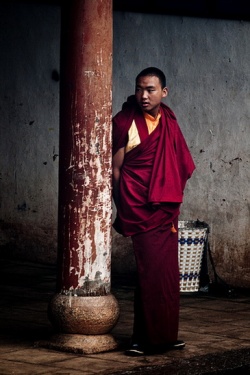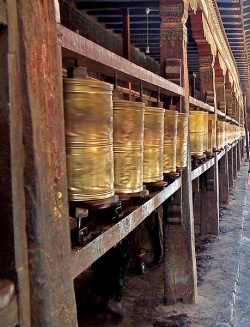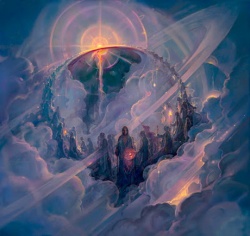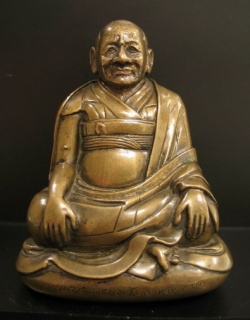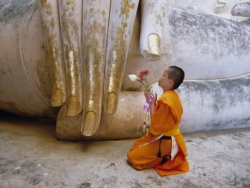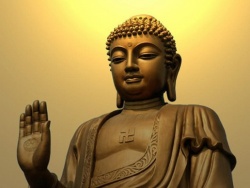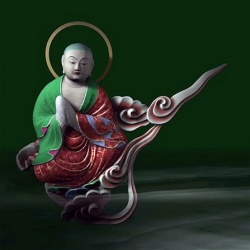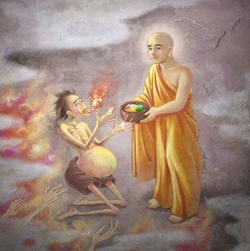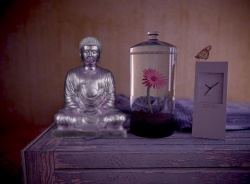The Dharma Flower Sutra seen through the Oral Transmission of Nichiren Daishōnin: The Eighth Chapter on the Prediction of Enlightenment for Five Hundred Disciples
The Dharma Flower Sutra
seen through the Oral Transmission of
Nichiren Daishōnin
The first important point concerning the parable of the priceless jewel sewn into the lining of the garment of the indigent individual in the Chapter on the Prediction of Enlightenment for Five Hundred Disciples.
The Oral Transmission on the Meaning of the Dharma Flower Sutra (Ongi Kuden) says that this is the chapter that recounts the parable of the priceless jewel sewn into the lining of the garment of the indigent individual. All the same, Nichiren and those who follow him are the people who reverently recite Nam Myōhō Renge Kyō, which is to devote our lives to and found them on the interdependence of cause, concomitancy and effect that pervades all the realms of dharmas that are in the entirety of existence. This means that these people have accepted with faith the jewel of the wisdom of the single vehicle to enlightenment of the Utterness of the Dharma (Myōhō, Saddharma). A mind of faith is to be compared to the jewel sewn into the lining of the garment of the indigent individual.
At that time, when Furuna (Pūrna, Maitrayani-putra) had listened to the Buddha’s explanation of the Dharma of the wisdom and discernment of using expedient means when it is suitable, as well as having heard the Buddha confer upon the major disciples the prediction of their attainment to the unexcelled, correct, and all-embracing enlightenment (anokutara sanmyaku sanbodai, anuttara-samyak-sambodhi) and furthermore had listened to the discourse about the causes and karmic relationships brought about by our former existences along with the power the of the all-embracing reaches of the mind of the Tathāgata that are entirely free from resistance, Furuna's (Pūrna, Maitrayani-putra) mind was filled with an unsullied exaltation.
He stood up forthwith and went towards the Buddha where he bowed in reverence to the feet of the World Honoured One and then withdrew to one side. There he remained, gazing at the Tathāgata without taking his eyes off him. Nevertheless, the following thought came into his mind:
The World Honoured One is incredibly remarkable, and what he does is fantastic. He conforms to all the variety of things that go on in the realms of existence (seken) in order to expound the Dharma in terms of expedient means and in this way to extirpate the multiple kinds of attachment to the self-indulgence of sentient beings. When it comes to the virtue of the Buddha, our words are unable to express it. Only the Buddha World Honoured One can know the long-cherished desires at the bottom of our hearts.
At that moment, the Buddha announced to the monks: Do you see Furuna (Pūrna, Maitrayani-putra) sitting there? I always say that he is by far the foremost among those who expound the Dharma and I respect his various good qualities. Diligently he holds to and protects my Dharma and also is helpful in its propagation. He is also capable of teaching the Dharma and explaining it to the four congregations of monks, nuns and devotees both male and female, as well as illustrating its advantages and giving these congregations a feeling of happiness. He is fully equipped to explain and make the correct Dharma of the Buddha understandable. At the same time, he adds to the spiritual richness of his fellow monks that practise the undefiled path of the bodhisattvas. Apart from the Tathāgata, nobody else could further the eloquence of such a discourse.
Then the Buddha said to the assembly: You must not think that Furuna (Pūrna, Maitrayani-putra) is simply capable of holding to and protecting my Dharma and helps in its propagation. He has also in the past, in the immediacy of ninety myriads of myriads of Buddhas, constantly held to and protected the correct Dharma of the Buddhas and aided and abetted its propagation. He was already the foremost in those times, among those to whom the Dharma was expounded.
Then again, Furuna (Pūrna, Maitrayani-putra) had a clear and penetrating insight into the concept of relativity (kū, shūnyatā). (This does not deny the concept of existence as such, but implies that all existence and its constituent elements are all dependent on the mechanism of cause, concomitancy and effect. Because causal factors are changing every instant, it follows that there cannot be a physically static reality. Everything that exists is relative and dependent on existing alongside all the other things that exist, either inside or outside our heads. This corresponds to the notion that existence is comparable to the lotus plant. which possesses both its flower and seeds (i.e., the interdependence of cause, concomitancy and effect) at the same time, hence the concept of the lotus plant as the embodiment of existence (tōtai renge). All that can be said is that all dharmas are respectively dependent on each other (kū, shūnyatā). This must not be confused with the denial of existence. Existence as we know it is a fundamental part of human experience.)
Furuna (Pūrna, Maitrayani-putra) also had arrived at the fourfold unhindered and unlimited wisdom (shi muge chi) to be able to expound. (These refer to 1) the content of the Dharma, 2) its meaning and its implications, 3) by using other languages and other forms of expression and 4) the pleasure of speaking about it eloquently.) Also, Furuna (Pūrna, Maitrayani-putra) was able to expound the Dharma distinctly and clearly without causing doubts or straying from the point.
Furuna (Pūrna, Maitrayani-putra) was capable of all the reaches of the mind of a bodhisattva. (They are 1) the sight of the deva (ten), 2) the hearing of the deva (ten), 3) the ability to see into the minds of other people, 4) the ability to understand the inherent karma of other people, 5) the ability to manifest oneself according to the propensities of other people and mentally travel elsewhere, 6) the capability to cut off all troublesome worries (bonnō, klesha).) He always practised according to the concepts of bramanical purity (bongyō) the whole of his lifetime. Those people living at the time of Shākyamuni Buddha all thought of themselves as only being one of the people who exerted themselves to attain the highest stage of the individual vehicle (shōjō, hīnayāna) through listening to the Buddha (shōmon, shrāvaka).
Due to all these various capabilities of this gifted person, he was able to enrich the lives of uncountable hundreds of thousands of sentient beings. Also he was able to convert boundlessly innumerable individuals as well as assuring the establishment of their unexcelled, correct, and all-embracing enlightenment. Because of his wish to purify the Buddha terrain where he lived, Furuna (Pūrna, Maitrayani-putra) was always occupied with the concerns of the Dharma by converting sentient beings through his teaching.
Now listen, monks. Furuna (Pūrna, Maitrayani-putra) was already the foremost of those who expounded the Dharma according to the last seven Buddhas of the past. At present, in my view, he is equally the foremost who expounds my Dharma now. Also in the future during a kalpa called Excellence, he will again be the foremost of those who expound the Dharma of all the Buddhas. He will always protect and hold to the Dharma of the enlightened, as well as assisting in its propagation. Again, further into the future he will hold to and protect the Dharma of boundlessly uncountable Buddhas (who all possess the same enlightenment) and again help and strive for its propagation. He will convert and teach innumerable sentient beings as well as enriching their lives through assuring the establishment of their unexcelled, correct, and all-embracing enlightenment.
In order to exalt the Buddha land upon which he depended for an existence, he constantly committed all his energy to the instruction and conversion of sentient beings. He will gradually complete the whole of the bodhisattva path and then after boundlessly uncountable kalpas have elapsed, he will attain the unexcelled, correct, and all-embracing enlightenment (anokutara sanmyaku sanbodai, anuttara-samyak-sambodhi). His name will be the Tathāgata Clearness of the Dharma (Hōmyō nyorai), who will be worthy of offerings and is correctly and universally enlightened, whose knowledge and conduct is perfect, lord supreme, the master who brings the passions and delusions of sentient beings into harmonious control, the teacher of humankind and the deva (ten), the Buddha, the World Honoured One.
This Buddha will have a single Buddha terrain which will consist of as many dimensions of existence as three thousand all-embracing thousands of times the number of grains of sand in the Ganges. The seven precious materials (1) gold, 2) silver, 3) lapis lazuli, 4) crystal, 5) agate, 6) rubies, 7) cornelian) will be the composition of the ground. The land will be as flat as the palm of a hand. There will be no mountains, hills nor valleys, canyons nor ditches nor embankments. There will be watchtowers made of the seven precious materials to be found everywhere. The palaces of the deva (ten) will be placed in the proximity of the empty space (that underlies all existence.). Both the deva (ten) and humankind will meet and also be able to see each other. The less fortunate paths that lead to rebirth (in various kinds of suffering of the hells, the avid craving of hungry ghosts or even the basic instincts of animals wants) will be nonexistent. Nor will there be any female beings. All the sentient beings in that Buddha land will be born through metamorphosis, and there will be no sexual longings.
These sentient beings will be endowed with special reaches (capacity, ability, mastery) of the mind such as emitting light from their bodies and will freely be able to go from one place to another, by simply flying. Their determination to become enlightened will be resolute and unyielding just as will their zeal and devotion or wisdom and discernment. All the sentient beings everywhere in that Buddha terrain will have golden bodies and be adorned with the thirty-two distinctive marks on the body of a Buddha. (They are 1) flat soles, 2) the wheel of the Dharma (Dharmachakra) on his soles, 3) slender fingers, 4) tender limbs, 5) webbed fingers and toes, 6) rounded heels, 7) long legs, 8) well-proportioned legs, 9) the length of his arms reaching below his knees, 10) a withdrawn penis like that of a horse, 11) his arm span equal to his body height, 12) light radiating from the pores of his skin, 13) curly body hair, 14) a golden coloured body, 15) light radiating from his body for about three meters in all directions, 16) slender shins, 17) legs, palms, shoulders and neck of the same proportions, 18) bulging armpits, 19) a dignified body like that of a lion, 20) a body that stands upright, 21) full muscular shoulders, 22) forty teeth, 23) firm white teeth, 24) four white canine teeth, 25) full cheeks like those of a lion, 26) saliva that has a pleasant flavour, 27) a long slender tongue, 28) a wonderful resounding voice, 29) ultramarine blue eyes, 30) eyes similar to those of a bull, 31) a white curl of hair between his eyes, 32) a protrusion on the top of his head.)
The sentient beings in that psychological dimension will always have two meals. One meal will be that of the happiness in the Dharma; the second dish will consist of the ecstasy of steady profound and abstract religious contemplation (zenetsu shoku). There will be an assembly of innumerable and untold thousands of myriads of myriads of myriads of bodhisattvas whose reaches of the mind will include the four unhindered or unlimited bodhisattva powers of wisdom and reasoning (as to 1) what the Dharma is, 2) its meaning and application, 3) to be able to express it in any language or form of expression and 4) with eloquence or the pleasure of communicating it.). They will all be capable of teaching and converting different kinds of sentient beings.
The number of people in this assembly who exert themselves to attain the highest stage of the teaching of the individual vehicle (shōjō, hīnayāna) through listening to the Buddha (shōmon, shrāvaka) will never be known. All of these people will be endowed with the six reaches of the mind. (They are 1) the sight of the deva (ten), 2) the hearing of the deva (ten), 3) the ability to penetrate the minds of other people, 4) the ability to understand the inherent karma of sentient beings, 5) the ability to manifest themselves according to the propensities of other people and mentally travel elsewhere, 6) the ability to cut off all troublesome worries (bonnō, klesha), as well as the three insights: i. the insight into the previous lives and deaths of oneself and others, ii. The insight of the deva (ten) to see into the future lives and deaths of oneself and others, iii. the insight into the troublesome worries (bonnō, klesha) in this actual life so as to be able to overcome all future passions and temptations.)
Furthermore, they will be completely endowed with the eight forms of deliverance (hachi gedatsu). (They are 1) deliverance from the subjective desires, that arise by the examination of the objects of such desires by becoming aware of the detrimental and negative qualities; 2) deliverance from when no subjective desires arise by still pondering over them, as above; 3) deliverance through concentrating on the vacuity (kū, shūnyatā) that underlines all existence so as to realise a permanent state of freedom from all longings and wanting; 4) deliverance in the realisation of the infinity of space and its immateriality (kū, shūnyatā); 5) deliverance in the realisation of the existence of infinite wisdom; 6) deliverance in the realisation that in fact nothing really exists and that everything is relative and dependent on causation; 7) deliverance through the state of mind where there is neither thought nor absence of thought, 8) deliverance in which there is a final extinction of all sensation and consciousness in nirvana.)
The boundless merits of that particular Buddha terrain will be realised and adorned in this manner. (It might be of interest to mention that many of the monks or these bodhisattvas and those who listen to the voice of the Buddha have more to do with the teachings that came before the Dharma Flower Sutra (Hokke-kyō). The object of the teachings of Nichiren is to enable ordinary people such as us to open up our inherent Buddha natures, with our persons and minds just as they are.) The name of the kalpa of this Buddha will be called Invaluable Brightness and the terrain will be referred to as the Auspicious Purity. The lifespan of this Buddha will be innumerable and boundless kalpas and his Dharma will continue for an extremely long time. After that Buddha will have passed over into nirvana, stupas will be built that are made of the seven precious materials (1) gold, 2) silver, 3) lapis lazuli, 4) crystal, 5) agate, 6) rubies, 7) cornelian), which will fill the whole of that existential dimension.
Then the World Honoured One, wishing to reiterate the meaning of what he had just expounded, expressed it again in the form of a metric hymn.
Yet they are far away
from the path of the Buddha.
But even then
they are able to give release
from the wheel of transmigration
to innumerable people
who will also attain
some kind of inner realisation.
In spite of the lack of desire
and laziness
of these intellectual seekers (shōmon, shrāvaka),
along with those
who are partially enlightened (engaku, pratyekabuddha),
they will in time substantiate
the fruition of Buddhahood,
hiding their inner selves
behind their bodhisattva practice
and giving the impression
that they are intellectual seekers.
Then with few desires
they show their repugnance
for the cycles of living and dying.
But in actual fact
these people are clearing the space
for their own Buddha terrain.
They show to the assembly
what the three poisons are (namely 1) concupiscence or wrong desire, 2) anger, hate, or resentment, 3) stupidity or unwillingness to accept the truth of the Buddha teaching)
or even point out
what the wrong way of seeing things is.
In this manner
many of my disciples
deliver people from the cycles of living and dying
through the use of their expedient means.
If I were to expound
in every detail
everything that appears before us
and how it will all change,
the minds of those sentient beings
who listen to this discourse
would be taken over
by doubts and bewilderment.
Furuna (Pūrna, Maitrayani-putra) who is here with us now
diligently practised on the path
of thousands of myriads
of Buddhas in the past.
Also he protected
and propagated
the Dharma of all these Buddhas,
in his quest for the unexcelled wisdom.
Even in the presence
of all these Buddhas
he sat at the head of the disciples
as being learned
and full of wisdom and discernment.
All that he expounded
was without reticence.
Also he knew how
to make his congregations feel happy
and yet he never became tired.
In this way, he helped the Buddhas.
Already he was fully equipped
with dharani spells
and magic formulae
connected with the six reaches
of the mind
such as the sight of the deva (ten),
the hearing of the deva (ten),
the ability to penetrate
the minds of the people,
the ability to understand
the inherent karma
of sentient beings,
the ability to manifest himself
according to the propensities
of other people
and mentally travel elsewhere,
the ability to cut off
all troublesome worries (bonnō, klesha),
along with the four unlimited
and unhindered bodhisattva powers
of interpreting the Dharma,
and its implications,
in any language
or form of expression
and eloquently
or with the pleasure of expounding.
He knew whether the faculties
of sentient beings
were either acute or dull.
He was always expounding
the purity of the Dharma
as well as elaborating
on its meanings.
Furthermore he taught
thousands of myriads
of myriads of people
inducing them to abide
with the universal vehicle (daijō, mahāyāna)
and at the same time clearing a space
for his own Buddha terrain.
Again in the future
he will make offerings
to innumerable
and incalculable Buddhas.
He will protect and help
to propagate the correct Dharma
as well as clearing a space
for his own Buddha terrain.
He will always fearlessly
expound the Dharma
using various kinds
of expedient means.
He will ferry uncountable persons
from the shores of mortality
to that of nirvana.
All these people
will substantiate the wisdom
of the intellectual seekers (shōmon, shrāvaka)
who exert themselves
to attain the highest stage
of the teachings
of the individual vehicle (shōjō, hīnayāna)
through listening to the Buddha (issaichi).
He will make offerings
to the Tathāgata
as well as protecting
and holding to the Dharma.
After that he will arrive
at the state of Buddhahood.
His name will be Clearness of the Dharma
and his Buddha terrain
will be called Auspicious Purity,
which will consist of
the seven precious materials (i.e., 1) gold, 2) silver, 3) lapis lazuli, 4) crystal, 5) agate, 6) rubies, 7) cornelian).
His kalpa will be called
Invaluable Brightness.
There will be very many bodhisattvas
in the assembly,
whose number will be counted
as incalculable boundless
myriads of myriads.
All of them will have reached the stage
of the six reaches of the mind (which are 1) the sight of the deva (ten), 2) the hearing of the deva (ten), 3) the ability to penetrate the minds of other people, 4) the ability to understand the inherent karma of sentient beings, 5) the ability to manifest themselves according to the propensities of other people and mentally travel elsewhere, 6) the ability to cut off all troublesome worries (bonnō, klesha)),
along with all the merits
needed for their authority.
They will all fill the Buddha terrain.
Also the intellectual seekers (shōmon, shrāvaka)
who exert themselves to attain
the highest stage
of the individual vehicle (shōjō, hīnayāna)
through listening to the Buddha
will also be without number.
They will be endowed
with the three insights (sanmyō) (which are 1) insight into the fundamental karma of oneself and others, 2) insight into the future inherent karma of others, 3) insight into the present inherent karma of oneself and others so as to be able to overcome all passions and delusions).
Also these intellectual seekers (shōmon, shrāvaka)
will be endowed with the eight
emancipated forms of deliverance (hachi gedatsu).
(These are 1) deliverance from the subjective desires that arise by the examination of the objects of such desires, by becoming aware of the detrimental and negative qualities; 2) deliverance from when no subjective desires arise by still pondering over them, as above; 3) deliverance through concentrating on the vacuity (kū, shūnyatā) that underlies all existence, so as to realise a permanent state of freedom from all longings and wanting; 4) deliverance in the realisation of the infinity of space and its immateriality (kū, shūnyatā); 5) deliverance in the realisation of the existence of infinite wisdom; 6) deliverance in the realisation that in fact nothing really exists and that everything is relative and dependent on causation; 7) deliverance through the state of mind where there is neither thought nor the absence of thought; 8) deliverance in which there is a final extinction of all sensation and consciousness in nirvana.)
Also these intellectual seekers (shōmon, shrāvaka)
will have acquired
the four unhindered powers
of being able to interpret
and expound (1) the Dharma, 2) its implications, 3) in any language or form of expression, 4) with eloquence and the pleasure of expounding it).
These achievements are what constitute
the clerical community (sō, sangha)
in this Buddha land.
All sentient beings
in this Buddha realm
will have no desire
for sexual relations
and they will be born
simply through metamorphosis.
Their bodies will be adorned
with the special characteristics
of the Buddha.
Their food will be
the joy in the Dharma
and the ecstasy of meditation.
Indeed they will have
no thoughts about eating
and there will be no women.
Moreover there will be no existence
of the three more unfortunate
paths of rebirth
which are sufferings
in the various hells
or the cravings of hungry ghosts
or the limited mental powers
of animality.
When the monk (bhikshu) Furana (Pūrna)
will have all his merits
entirely fulfilled,
he will receive
this immaculate terrain
that will abound
with wise persons and bodhisattvas.
These concerns are so boundless
that I now only express them
in general terms.
Thereupon the following thought came to the minds of the thousand two hundred persons who had reached the highest stage of the individual vehicle (shōjō, hīnayāna), whose minds were completely and independently self-directing: “We would be overjoyed as never before if the World Honoured One were to confer on each one of us the affirmation of our future attainment of Buddhahood in the same way as he has done with other major disciples. This would make us really happy.”
The Buddha who was aware of what was going on in the minds of these disciples said to Makakashō (Mahākāshyapa):
With regard to these one thousand two hundred persons who have reached the highest stage of the individual vehicle (shōjō, hīnayāna), I am now going over to them in person in order to confer upon them one after another the proclamation of their future attainment to the unexcelled, correct, and all-embracing enlightenment (anokutara sanmyaku sanbodai, anuttara-samyak-sambodhi). In this assembly my major disciple the monk (bhikshu) Kyōjinnyo (Kaundinya) will make offerings to sixty-two thousand myriads of Buddhas and naturally after that he will realise the state of Buddhahood. His name will be the Tathāgata Universal Luminosity (Fumyō), worthy of offerings, correctly and universally enlightened, whose knowledge and conduct is correct, completely free from the cycles of living and dying, yet with a complete understanding of the realms of existence, lord supreme, the master who brings the passions and delusions of sentient beings into harmonious control, the teacher of humankind and the deva (ten), the Buddha who is the World Honoured One.
These five hundred persons who have attained the highest stage of the individual vehicle (shōjō, hīnayāna), Urubinrakashō, Gayakashō, Nadaikasho, Karudai, Udai, Anuruda, Rihata, Kohinna, Hakura, Shuda, Shakada, along with all the others will reach the state of the unexcelled, correct, and all-embracing enlightenment (anokutara sanmyaku sanbodai, anuttara-samyak-sambodhi). They will all unanimously have the name Universal Luminosity (Fumyō).
Thereupon the World Honoured One, wishing to reiterate the meaning of all that he had said, expressed it in the form of a metric hymn.
The monk (bhikshu) Kyōjinnyo (Kaundinya)
will reverently look upon
uncountable Buddhas
over a period
of incalculable kalpas.
Afterwards he will attain
the unexcelled, correct
and all-embracing enlightenment.
Then he will emit
an all-embracing clear bright light
and will be fully equipped
with all the various reaches of the mind.
His notability will fill
the ten directions of the universe
and he will be rewarded by all.
He will continually expound
the unexcelled path (the theme and title (daimoku)).
This is why he will be called
Universal Luminosity (Fumyō)
and the terrain whereupon he depends
for an existence
will be immaculately pure.
All the bodhisattvas
in that dimension
will be brave and intrepid.
On that Buddha terrain
there will be exquisite towers erected.
Also the bodhisattvas
will travel to the existential spaces
in all the ten directions
of the universe
and with various kinds of offering
they will render homage
to all the Buddhas.
Then after having made these donations
they will feel great joy in their hearts.
In an instant, they will return
to their own terrain
since they will be endowed
with such reaches of the mind.
The lifespan of that Buddha
will be sixty thousand kalpas
and the period
of his correct Dharma
will last for twice that amount of time.
The period in which his Dharma
will degenerate
into ritualistic semblances
will again be double the lifetime
of that Buddha
and when the Dharma of the Buddha
comes to its end
both the deva (ten) and humankind
will pine away and grieve.
These five hundred monks
will gradually attain enlightenment
and they will all have the same name,
which will be
Universal Luminosity.
In turn they will all receive
the prediction
of their attainment to Buddhahood.
After my passing over
into nirvana
each of these monks will become a Buddha
and the world will be converted by them
and will be like this world of mine today,
the adornment of the terrains
upon which they will depend
for an existence
along with the reaches of their minds.
The bodhisattvas
and the intellectual seekers (shōmon, shrāvaka)
and the length of time in which their Dharma
will remain in its correct form
as well as when it will degenerate
into superficial,
liturgical ceremonies
and the quantity of kalpas
will all be as predicted.
Kashō (Kashyapa), you know already
that these five hundred persons
whose minds are completely their own
along with this assembly
of the intellectual seekers (shōmon, shrāvaka)
will, whatever happens,
ultimately be fully enlightened.
For those who are not at present
in this assembly,
you must tell them about it.
Then all the five hundred persons who had attained the highest level of the teachings of the individual vehicle (shōjō, hīnayāna), who were able to receive the annunciation of their future substantiation of Buddhahood in the presence of the World Honoured One, exulted over such predictions. They stood up from their seats and went before the Buddha bowing their heads towards him.
Regretting their former resentment, they reproached themselves and said to the Tathāgata: We always had the idea that we had finally realised the total extinction of our being in nirvana. But now we have become aware of the fact that we are the same as the unenlightened. Why is this so? Since we will attain the wisdom of the Tathāgata in the future, then we will be for the time being content with the little wisdom we possess.
World Honoured One, you must imagine that there was a person who visited the house of an intimate friend where he got drunk on wine and then fell into an unconscious state.
The second important point with regard to the sentence, “You must imagine that there was a person who visited the house of an intimate friend where he got drunk on wine and then fell into an unconscious state.”
The Oral Transmission on the Meaning of the Dharma Flower Sutra (Ongi Kuden) says that the wine represents the unclearness as to what existence is all about and that such confusion implies belittling the truth of the Dharma. To fall into an unconscious state means to be born into a family that underestimates the truth of the Dharma. At a psychological depth it is expressed in terms of a period of time in the past that would be as impossible to calculate as the number of particles of dust that would be left over if someone were to grind three thousand universes into powder.
Nevertheless various people got drunk on the wine of negative karmic relationships and ended up by transmigrating through either the five or six paths of reincarnation. (They are 1) the suffering of various hellish dimensions (jigokukai), 2) the cravings and wants of hungry ghosts (gakikai), 3) the limited possibilities of awareness and instinctive qualities of animality (chikushokai), 4) the titanic ostentation, pretence, arrogance and anger of the ashura (shurakai), 5) the composure and equanimity of humankind (jinkai), and 6) the ecstasies and passing delights of the deva (tenkai).) So now these people are born into families that underestimate the truth of the Dharma.
To be drunk means to have no faith in the Dharma. To become sobered up means to have faith in it. Now, Nichiren and those that follow him reverently recite Nam Myōhō Renge Kyō, which means to devote our lives to and found them on (Nam(u)) the Utterness of the Dharma (Myōhō) (entirety of existence) permeated by the underlying white lotus flower-like mechanism of the interdependence of cause, concomitancy and effect (Renge) in its whereabouts of the ten (psychological) realms of dharmas (Kyō) and thereby is the waking up from the influence of the wine of our confusion of what existence is all about.
Also, The Oral Transmission on the Meaning of the Dharma Flower Sutra (Ongi Kuden) states that with regard to the wines that represent our bewilderment, there are various levels. For instance, the provisional teachings that came before the Dharma Flower Sutra (Hokke-kyō) are a particular kind of wine that brings about bewilderment whereas the Dharma Flower Sutra (Hokke-kyō) itself is a means to sober up.
When the teachings that are derived from the external events of Shākyamuni’s life and work (shakumon) are confronted with the teachings of the original archetypal state (honmon), then such doctrines are another kind of intoxicant that also bring about our bewilderment. This is because the teachings that are derived from the external events of Shākyamuni’s life and work specify that the Tathāgata Shākyamuni attained to his enlightenment when he was thirty, under the bodhi tree near Buddhagāya in the then kingdom of Magadha. The teachings that refer to the original archetypal state stipulate that he had been enlightened in a remote past that amounts to what the three thousand kalpas reduced to particles of dust might be, in other words eternity and beyond time.
Again, the gateways to the Dharma of the teachings that are derived from the external events of Shākyamuni’s life and work (shakumon) along with those that are based on the original archetypal state (honmon) are both intoxicants that cause bewilderment. On the other hand, Nam Myōhō Renge Kyō (which is to devote our lives to and establish them on the whereabouts of the interdependence of cause, concomitancy and effect that pervades the entirety of existence, which means that we devote our lives to and establish them on life itself) is the elixir that brings us back to our senses.
Both the intoxication (of being involved in our own lives) and the sobering up or awakening to what our lives are all about are mutually inseparable. The intoxicant is the absence of clarity as to how we should understand what life is concerned with. The sobering up is our awakening to the essence of the Dharma (which is everything that is implicated in Nam Myōhō Renge Kyō). The intoxicant consists of the dharmas that we are involved with, whilst Utterness is the realisation of the entirety of our existence, as well as our sobering up.
When we recite the title and the theme (daimoku) of the Utterness of the Dharma (Myōhō, Saddharma), we recognise that our unenlightenment and the essence of the Dharma are a single entity. In the first volume of Tendai’s (T’ien T’ai) Universal Desistance from Troublesome Worries in order to See Clearly, it says that the six qualities produced by dharmas that touch upon our organs of sense – 1) appearance, 2) sound, 3) smell, 4) taste, 5) feeling or touch and 6) our mental reactions along with the troubles they bring about – are not separate from enlightenment as the quintessence of wisdom.
His close friend had to leave on some official business. He sewed a priceless pearl into the lining of the garment of the man who was asleep as a gift and then the close friend left. The man who had got drunk was so helplessly inebriated that he was not aware of anything. Then when this man who was intoxicated woke up, he set out on a journey and arrived in another country. (At the time of Shākyamuni, India was divided into a number of smaller countries like medieval Europe.)
In order to find food and clothing he had to make enormous efforts under extreme hardship. Even if he were to earn even the smallest amount, it was never really enough to survive.
Then by chance he stumbled across his close friend who on seeing the state of this person who had got drunk at his house said, “How did you get into this condition so that you cannot even eat and clothe yourself? A long time ago in order to assure your peace and comfort so that you could live and satisfy your five desires (i.e., 1) the desire for wealth, 2) sexual love, 3) eating, drinking, 4) renown and 5) sleep), I sewed a priceless pearl in the lining of your garment. Now everything is all right. The pearl is still there, yet you did not know about it. To strive for your subsistence through hard toil and bitter trouble is the culmination of stupidity. You can now trade this treasure for everything you need and can do as you wish without having to do without anything.”
In the same way as these persons who had recounted this anecdote and who had reached the highest level of the teaching of the individual vehicle (shōjō, hīnayāna), it is the same way of teaching as the Buddha. When he was still a bodhisattva he converted us through his teaching which led us to the all-knowingness (issaichi) of the intellectual seekers (shomon) and those people who are partially enlightened due to a profound search for the meaning of existence (engaku, hyakushibutsu, pratyekabuddha).
Then we became unmindful of this level of all-knowingness and were no longer aware of it. We thought we had already attained the path to the highest stage of the teachings of the individual vehicle (shōjō, hīnayāna) and that we were set on the way out of the cycles of living and dying and to arrive at their extinction in nirvana. Then it became psychologically difficult to carry on living, so we contented ourselves with the scraps that came our way. Nevertheless, our aspiration to the all-knowingness of the intellectual seekers and those who are partially enlightened (issai chi) still persists. It is something we have never lost.
Now this is what the World Honoured One has to say about what we assumed was our enlightenment:
All you monks, what you have substantiated is not the ultimate extinction of the cycles of living and dying in nirvana. For a long time now I have been setting down in your personalities good roots for your Buddha enlightenment. But through various expedient means (hōben), I have been showing you the various aspects of nirvana, so that you thought that you had reached an exemption from the cycles of living and dying and had passed over to their extinction in nirvana.
World Honoured One, we now realise that in actual fact we are bodhisattvas. We have been able to receive the announcement of our future attainment to the unexcelled, correct, and all-embracing enlightenment. It is for this reason we are certainly overjoyed. This is something we have never had before.
There and then Kyōjinnyo (Kaundinya) and all the others, who wished to reiterate the meaning of what they had said, expressed it in terms of a metric hymn.
We have heard the peerless voice
that has conferred
the reassurance and encouragement
of the annunciation
of our future attainment
to the state of Buddhahood.
We rejoice in this benefit
that we have never had before
and we show our reverence to the Buddha
who possesses immeasurable wisdom.
Now, before the World Honoured One,
not having the boundless treasure
of the Buddha
and holding to only a fraction
of nirvana,
this is comparable to a poor man
who arrives at the house of a close friend
whose family is extremely prosperous,
where this poor man is given
all sorts of delicate dishes.
While the poor man is in a drunken sleep
the host sews a pearl beyond price
into the lining of his garment.
Then the host leaves in silence
having made this present to his friend.
During the time the indigent man
is fast asleep
he is not aware of anything.
But when he wakes up
he goes on a journey
and arrives at a foreign country.
In his search for food and clothing
in order to subsist,
he has the greatest difficulties
in being able to make ends meet,
such small earnings that are barely enough;
but he aspires to nothing better.
He is not aware of the pearl
of inestimable value
sewn into the lining of his clothing.
The close friend
who gave this poor man the pearl
on seeing the condition
of this indigent person
looked disgusted
and severely reproached him.
Then he showed this poor man
the pearl that was sewn
into the lining of his cloths.
The poor man on seeing the pearl
was overwhelmed with joy.
He had become rich
and possessed a fortune.
From now on,
he could do as he wished
according to his five desires (namely 1) the desire for wealth, 2) sexual love, 3) eating and drinking, 4) renown and 5) sleep).
It is also the same way for us.
The World Honoured One
who all through the long night
of transmigrations, living and dying
has always had pity on us
and converted us through his teaching,
so as to implant in us
the unsurpassable aspiration
to become enlightened.
But on account of our lack
of wisdom and perception
we were not aware of anything.
We thought we had accomplished
a minimal part of our extinction
in nirvana
with which we were content
and looked for nothing more.
Now the Buddha has warned us
that what we had attained
was not the real passage
from the shores of mortality
to the shore of extinction in nirvana.
It is on attaining
the peerless wisdom of the Buddha
that we will realise
what the real extinction in nirvana is.
Now we have heard from the Buddha
the announcement
of our future enlightenment
along with a description
of the adornments
of our respective existential realms of Buddhahood.
Now each one of us waits in turn
for the realisation
of these predictions
that announce our attainment
to the enlightenment of Buddhahood,
so that our bodies and minds
are completely filled with joy.
The third important point concerning the final two lines of the Eighth Chapter on the Prediction of the Five Hundred Disciples who will become enlightened, “so that our bodies and minds are completely filled with joy”.
The Oral Transmission on the Meaning of the Dharma Flower Sutra (Ongi Kuden) says that the word “bodies” in this context refers to the cycles of living and dying not being separate from nirvana (shōji soku nehan). (Originally, nirvana implies the state of enlightenment that was substantiated by Shākyamuni. This means it is a state that can be attained through liberating oneself from all the illusions which are the constituents of our respective existences as well as elimination of all the karma that brought about all our existences. According to some schools, this extinction in nirvana becomes the enlightenment that is realised through the Buddha wisdom and is conceived as being positive in nature and infinite. nirvana is also seen as not coming into being (fushō); nor does it ever come to an end (fumetsu). nirvana can also be equated with the embodiment of the Dharma (hosshin, Dharma-kāya), which is the pure relativity (kū, shūnyatā) that underlies all existence. The embodiment of the Dharma (Dharma-kāya) is the primordial state and the clear light that is seen after entering the condition that occurs between dying and rebirth. The realisation of this primordial vacuity (nehan, nirvana) is the goal of those who follow the teachings of Shākyamuni Buddha. But for those of us who follow the teachings of Nichiren, the object is to open up our inherent Buddha nature, with our persons just as they are.)
Again in this context the word “mind” refers to the bustle that goes on in our heads not being separate from (soku) our fundamental enlightenment which is life itself (bonnō soku bodai). The words “are completely” imply the ten psychological dimensions in which dharmas occur (jikkai). (These are 1) the sufferings of the hells (jigokukai), 2) the cravings and wanting of hungry ghosts (gakikai), 3) the limited possibilities of intelligence and instinctive qualities of animality (chikushōkai), 4) the extravagant behaviour and anger of the shura or titans (shurakai), 5) the ordinary level of human equanimity (jinkai), 6) passing ecstasies of the deva (ten) and the fleeting quality of our personal joys (tenkai), 7) the various realms of the intellectual seekers (shōmon, shrāvakakai), 8) the psychological dimensions of people who are partially enlightened due to a profound search for the meaning of existence (engakukai, pratyekabuddha), 9) people who seek enlightenment not only for themselves but also for others (bosatsukai), 10) the fully enlightened state of the Buddha who knows the truth of all things (Bukkai).) These ten psychological reaches of the mind oscillate with each other continuously (and thus induce the dharmas to appear which are the ingredients of our respective lives).
Here the word “joy” refers to the exhilaration experienced by the whole of the Dharma realm (hokkai) simultaneously. Within this joy is placed the happiness of all the Buddhas of the past, present and future.
Now, Nichiren and those that follow him reverently recite Nam Myōhō Renge Kyō which means to devote our lives to and found them on (Nam(u)) the Utterness of the Dharma (Myōhō) (entirety of existence) permeated by the underlying white lotus flower-like mechanism of the interdependence of cause, concomitancy and effect (Renge) in its whereabouts of the ten (psychological) realms of dharmas (Kyō).
This alludes to the Shākyamuni Buddha as the fundamental of existence expressing his joy as in the metric hymn in the Eleventh Chapter on the Seeing the Vision of the Stupa made of Precious Materials when he says, “It is difficult to trust implicitly this sutra. If there is a person who can hold faith in it even for a short time, I am joyously pleased (kangi) and so are all the Buddhas.”
This joy is equally shared by both the positive and negative dimensions of existence, since the ten realms where dharmas occur all function alongside each other. You should deeply ponder over this.
Continue Reading
- The Dharma Flower Sutra seen through the Oral Transmission of Nichiren Daishōnin: Preface
- The Dharma Flower Sutra seen through the Oral Transmission of Nichiren Daishōnin: Synopsis of the Dharma Flower Sutra (Hokke-kyō) Trilogy
- The Dharma Flower Sutra seen through the Oral Transmission of Nichiren Daishōnin: The First and Introductory Chapter
- The Dharma Flower Sutra seen through the Oral Transmission of Nichiren Daishōnin: The Second Chapter on Expedient Means
- The Dharma Flower Sutra seen through the Oral Transmission of Nichiren Daishōnin: The Third Chapter on Similes and Parables
- The Dharma Flower Sutra seen through the Oral Transmission of Nichiren Daishōnin: The Fourth Chapter on Faith Leading to Understanding
- The Dharma Flower Sutra seen through the Oral Transmission of Nichiren Daishōnin: The Fifth Chapter on The Parable of the Medicinal Herbs
- The Dharma Flower Sutra seen through the Oral Transmission of Nichiren Daishōnin: The Sixth Chapter on The Disclosure of the Future Record Of those who will attain Enlightenment
- The Dharma Flower Sutra seen through the Oral Transmission of Nichiren Daishōnin: The Seventh Chapter on The Parable of the Imaginary City
- The Dharma Flower Sutra seen through the Oral Transmission of Nichiren Daishōnin: The Eighth Chapter on the Prediction of Enlightenment for Five Hundred Disciples
- The Dharma Flower Sutra seen through the Oral Transmission of Nichiren Daishōnin: The Ninth Chapter on the Announcement of the Future Attainment to Buddhahood of Both Those who Need and Do Not Need Instruction
- The Dharma Flower Sutra seen through the Oral Transmission of Nichiren Daishōnin: The Tenth Chapter on The Dharma as a Teacher
- The Dharma Flower Sutra seen through the Oral Transmission of Nichiren Daishōnin: The Eleventh Chapter on Seeing the Vision of the Stupa made of Precious Materials
- The Dharma Flower Sutra seen through the Oral Transmission of Nichiren Daishōnin:The Twelfth Chapter on Daibadatta (Devadatta)
- The Dharma Flower Sutra seen through the Oral Transmission of Nichiren Daishōnin:The Thirteenth Chapter on Exhorting the Disciples to Receive and Hold to the Buddha Teaching
- The Dharma Flower Sutra seen through the Oral Transmission of Nichiren Daishōnin:The Fourteenth Chapter on Practising in Peace and with Joy
- The Dharma Flower Sutra seen through the Oral Transmission of Nichiren Daishōnin:The Fifteenth Chapter on the Bodhisattvas who Swarm up Out of the Earth
- The Dharma Flower Sutra seen through the Oral Transmission of Nichiren Daishōnin:The Sixteenth Chapter on the Lifespan of the Tathāgata
- The Dharma Flower Sutra seen through the Oral Transmission of Nichiren Daishōnin:The Seventeenth Chapter on Discerning the Meritorious Virtues
- The Dharma Flower Sutra seen through the Oral Transmission of Nichiren Daishōnin:The Eighteenth Chapter on the Joy of the following Meritorious Virtues of Practice
- The Dharma Flower Sutra seen through the Oral Transmission of Nichiren Daishōnin:The Nineteenth Chapter on the Meritorious Virtues of the Teacher who Propagates the Dharma Flower Sutra
- The Dharma Flower Sutra seen through the Oral Transmission of Nichiren Daishōnin: The Twentieth Chapter on the Bodhisattva Not Holding Anyone or Anything in Contempt Ever (Jōfukyō, Sadapāribbhūta)
- The Dharma Flower Sutra seen through the Oral Transmission of Nichiren Daishōnin: The Twenty-first Chapter on the Reaches of the Mind of the Tathāgata
- The Dharma Flower Sutra seen through the Oral Transmission of Nichiren Daishōnin: The Twenty-second Chapter on the Assignment of the Mission
- The Dharma Flower Sutra seen through the Oral Transmission of Nichiren Daishōnin: The Twenty-third Chapter on the Original Conduct of the Bodhisattva Sovereign Medicine (Yaku’ ō, Bhaishajya-rāja)
- The Dharma Flower Sutra seen through the Oral Transmission of Nichiren Daishōnin: The Twenty-fourth Chapter on the Bodhisattva Sound of Utterness (Myo ‘on, Gadgadasvara)
- The Dharma Flower Sutra seen through the Oral Transmission of Nichiren Daishōnin: The Twenty-fifth Chapter on the Universal Gateway of the Bodhisattva Perceiving the Sound of the Existential Dimensions (Kanzeon, Avalokiteshvara)
- The Dharma Flower Sutra seen through the Oral Transmission of Nichiren Daishōnin: The Twenty-sixth Chapter on Dhāranī
- The Dharma Flower Sutra seen through the Oral Transmission of Nichiren Daishōnin: The Twenty-seventh Chapter on the Original Conduct of King Utterly Embellished (Myōshōgonnō, Shubhavyūha)
- The Dharma Flower Sutra seen through the Oral Transmission of Nichiren Daishōnin: The Twenty-eighth Chapter on the Persuasiveness and Quest (for Buddhahood) of the Bodhisattva Universally Worthy (Samantabhadra, Fugen)
